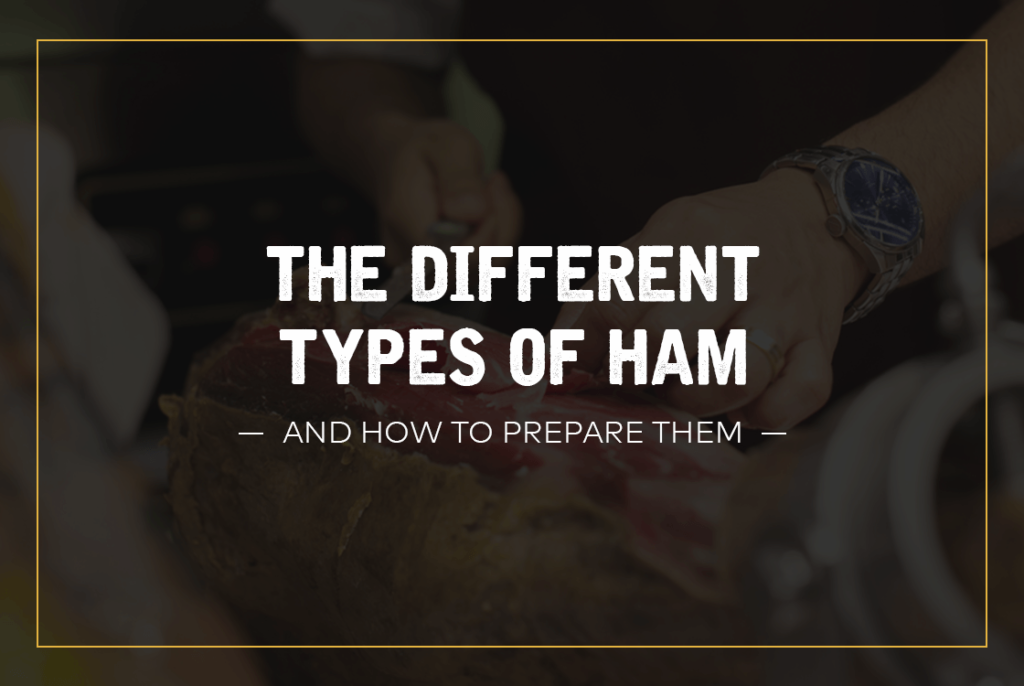
From huge holiday celebrations to everyday school lunches, ham is an iconic meat that can make any meal better. Whether you need to fill out a sandwich or come up with a breathtaking main course for a special event, you can find a type of ham to meet all your culinary needs. However, shopping for the best ham can be overwhelming since you’ll run into many labels and descriptions that may have you wishing you had a culinary dictionary handy.
If terms like “cured,” “uncured,” “smoked” and “shank” sound like a foreign language to you, you’ve come to the right place. This ultimate guide to the different types of ham and how to prepare them will go over what ham is, the history of ham, uncured vs. cured ham, the different types of ham and how to cook them. Keep reading to find out all the kinds of ham available to you and how to make them taste their best.
What Is Ham?
Ham is a type of pork that comes from the hind leg of a hog. Ham can be preserved and prepared in many different ways. Like many other cuts of meat, ham can simply be roasted with the bone either in or out. However, ham can also be pre-cured and cooked in a wide variety of ways to make it a prepared ham.
What Does Ham Meat Taste Like?
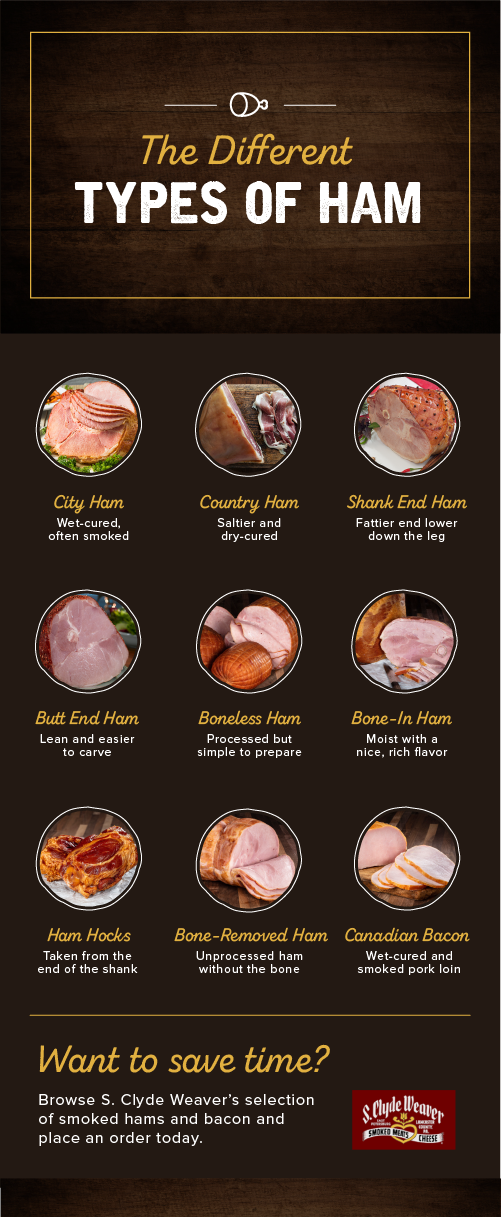
The exact taste of a piece of ham varies greatly depending on how it is prepared and served. Still, all types of ham have a few common characteristics. Because ham comes from the large, round muscles of a hog’s hind leg, every type of ham has a meaty denseness and a fleshy texture. Whether smoked, oven-roasted or aged and sliced thinner than a piece of paper, your ham will have a sturdy meatiness to it.
In addition to its satisfying texture, all ham has a slight, underlying sweetness to its taste. Although ham’s flavor profile is overall savory and rich, ham always has a hint of sweetness no matter how it was prepared. Even smoked or salted hams have notes of sweetness. These sugary undertones make ham the perfect partner for numerous accent flavors, pairing especially well with salt, smoke, brown sugar, maple, spicy mustard, cloves and even canned pineapple.
What Is The History of Ham?
The oldest surviving book of Latin prose from the first century BC includes instructions for preparing ham, so it’s safe to say humankind, and especially Westerners, have enjoyed ham for a very long time. The word “ham” comes from the Old English “hom” or “ham,” which means the bend or hollow of the knee. Around the 15th century, this word started being used to refer to the cut of pork from a hog’s hind leg that we now know as ham.
According to historical records, China was the first place to mention the production of cured ham, meaning the Chinese likely invented the curing process. By the time of the Roman Empire, curing ham had become a well-established practice and cured ham was a popular, tasty trade item. Cured ham from specific areas became particularly sought after because curing ham requires certain conditions.
When curing meat, the environment cannot be so cold that the curing process can’t occur or the ham freezes. However, it also cannot be so warm that the ham spoils. In the Old World, this need for the perfect curing conditions made geographic regions within Italy and Spain renowned for their delicious cured ham products.
Nowadays, thanks to modern technology, climate control and automated food production processes, cured ham is made all over the world. However, many regions of the world are still known for specializing in ham products. For example, Europe is regarded for its prosciutto di Parma and the United States is famous for its Smithfield ham.
Modern Uses of Ham
In the United States, ham is often used in its sliced form to fill sandwiches and similar foods. Specifically, the ham and cheese sandwich is a classic lunchtime staple for many Americans. Other ham sandwiches include toasted sandwiches such as the Cubano, which uses two types of pork, melted Swiss cheese, pickles and mustard to create a tangy, tart meal.
Along with stuffing sandwiches, ham is frequently found topping pizzas in the States, such as the Hawaiian-style pizza that features ham and pineapple. In other parts of the world, ham is a centerpiece in traditional dishes. Check out these famous ham dishes from all over the globe:
- Croque-monsieur: This delicious French recipe is a baked or fried sandwich filled with boiled ham and cheese. Although originally served in French bars and cafes as a quick snack, the croque-monsieur has become an international delight. When served as a Croque Madame, the ham and cheese sandwich gets topped with a fried egg.
- Jambon-beurre: Another popular French sandwich, the jambon-beurre is made by slicing a baguette open, spreading butter on one or both sides and filling the baguette with slices of ham.
- Budae-jjigae: This Korean stew includes ham, sausage, spam, kimchi, instant noodles, baked beans and gochujang, which is a red chili paste.
- Denver omelet: A Denver omelet folds diced ham, green bell peppers and chopped onions into the traditional fluffy egg dish.
- Denver sandwich: Similar to the Denver omelet, the Denver sandwich consists of ham, green bell peppers, onions and scrambled eggs tucked between two pieces of bread or toast. Sometimes, additional ingredients are included.
- Jambon: Most delis in Ireland sell jambon, a square pastry filled with chunks of ham and cheese.
- Ham and egg bun: This dish is a savory pastry from Hong Kong that is made by putting ham and egg in a bun.
- Francesinha: This Portuguese sandwich is a rich dish made by layering wet-cured ham, Portuguese smoke-cured pork, sausage and steak or another roasted meat on bread, then covering it with melted cheese. The sandwich is usually smothered in a hot spiced tomato and beer sauce as well.
- Pan de jamon: Pan de jamon is a traditional Venezuelan Christmas bread that’s filled with ham, green olives, fried bacon and raisins.
- Ham cordon bleu: Cordon bleu refers to any meat being wrapped around cheese, then getting breaded and either pan-fried or deep-fried. Ham cordon bleu often involves stuffing the ham with mushrooms as well as cheese.
- Gammon: Gammon is a British pork leg cut that can be whole or sliced and has been cured but needs some extra cooking. Once gammon has been cooked, it becomes a beautiful, savory centerpiece for holiday dinners throughout the United Kingdom.
- Ham salad: Ham salad is similar to chicken salad or tuna salad in the sense that it mixes ham with chopped veggies, mayonnaise and some dressing to create a tasty salad.
- Schnitz un knepp: This delicious Pennsylvania Dutch dish consists of ham alongside dried apples and dumplings.
- Stuffed ham: This simple recipe comes from southern Maryland and features a corned ham stuffed with seasoned greens.
- Toast Hawaii: In this classic Hawaiian meal, a slice of toast gets topped with ham, a slice of fresh pineapple, cheese and a maraschino cherry.
While the ham recipes listed above are each scrumptious in their own way, ham is most widely recognized as being the showstopping entree for a special occasion. Namely, ham is an extremely popular Christmas dinner dish. However, a big spiral-sliced ham is an easy and impressive entree choice for any large gathering or celebration.
From Christmas and Easter to a wedding or graduation party, here are the top five reasons to serve ham at your next big party:
- Ham is simple yet stunning: Serving ham at a gathering is an easy way to present your dinner guests with a picturesque entree without breaking a sweat. Cooking ham is a straightforward process that even a novice chef can pull off. If you purchase a spiral-sliced ham, you don’t even have to worry about carving the meat on your own.
- Ham can feed a crowd: Ham is a great entree for large events because it is a sizable, filling type of meat that will leave your guests feeling satisfied. Buying a ham ensures that you’ll have plenty of meat to go around without spending as much as you would for another, more expensive type of meat like prime rib.
- You can customize ham: Depending on how much time and effort you want to put into making your ham, you can dress it up as much as you’d like. If you want your ham to be on the sweet side, you can whip up a maple or fruit glaze and top it with pineapple rings. On the other hand, you can embrace the saltier side of your ham by preparing a creamy mustard sauce to douse it in.
- Ham’s serving temperature is flexible: Many main entrees need to be served hot, which can be challenging for a drop-in event where the food is out the entire time for guests who are coming and going. Serving ham solves this issue because ham can be enjoyed both warm and at room temperature. As a bonus, when you serve ham, you don’t have to worry about whether some people like their meat more well done or rare as you would when serving other meats like roast beef.
- Ham goes well with a wide range of side dishes: Unlike most meats, ham does not get smothered in gravy, making it compatible with anything from a simple side salad or dinner roll to baked beans or potatoes au gratin. Ham’s flavors will go well with whatever your specialty side dishes are, so you don’t have to learn a new recipe. For a delightful twist, serve Lebanon bologna alongside ham, offering guests a chance to create their own sandwiches with freshly made bread, rolls, or biscuits, complemented by a variety of cheeses and spreads. This way, you can enjoy the rich, savory flavors of both meats in a fun and interactive way!
How Is Ham Made?
Hams are cut from the rear leg of a pig. The exception to this is picnic ham, which is really not ham at all. These “hams” are cut from the front leg. If a rear leg cut of meat were immediately cooked, it would simply taste like any other pork roast. You can buy fresh hams from butchers, but in most cases, hams go through a curing process and a baking or smoking process, which helps to give them their signature taste and texture before being sold.
Uncured vs. Cured Ham
When you’re shopping for ham, you have the choice between uncured and cured ham. Simply put, cured ham has gone through a curing process designed to preserve the meat without refrigeration. This process often involves a variety of chemicals and additives. On the other hand, uncured meats have not been treated with preservatives and must rely on natural salts and flavorings to keep from going bad.
Both cured and uncured hams offer their fair share of benefits and drawbacks. Before making your ham decision, check out the following sections on what cured ham and uncured ham bring to the table.
What Is Cured Ham?
To understand what uncured ham is, you first need to know what cured ham is. Unless labeled otherwise, the ham you find at your local grocery store is most likely cured ham. Cured ham is a popular grocery store and deli counter item because any ham product labeled as cured, baked or smoked is essentially pre-cooked and safe to consume.
When it comes to curing ham, manufacturers can either follow a dry curing or wet curing process. Some traditional dry-cured hams use salt as the sole curative agent, although this is becoming less common. Most dry-cured hams incorporate various herbs and spices for added flavor. Dry curing starts with cleaning the raw ham, then covering it in salt as it gets gradually pressed to drain out all the blood.
After this step, the spices and seasonings are added to the ham. Next, the ham is washed and hung up in a dark, temperature-regulated space to dry. Depending on the type of ham being dry-cured, the ham could be hung up for months or even years while its flavors develop. Dry-cured hams can also be aged for a rich, intense flavor.
Once the drying period is over, you can usually eat the dry-cured ham without being cooked. Dry-cured hams can last a long time because they’ve been drained of the moisture that would otherwise breed bacteria. This also means dry-cured hams can be kept at room temperature.
Many modern dry curing practices also include using nitrates, along with the traditional salt, to preserve the meat. Nitrates can prevent bacteria growth while giving the ham an aesthetic dark red color. However, many people are skeptical about the use of chemicals in meat and choose to shop for nitrate-free ham.
When ham goes through the wet curing process they are brined, then fully cooked either in an oven or a smoker. The brining process involves completely immersing the meat in a brine for several days, allowing the ham to soak up the brine’s flavors and ingredients, such as sugar, spices and seasonings.
To speed up the wet curing process, some manufacturers inject the ham with the wet curing solution. The mixture usually includes water, salt, brown sugar, flavorings and chemicals like sodium nitrate, sodium phosphate and more. This method speeds up the wet curing process, more evenly distributes the salt throughout the meat and increases the final weight of the ham by even more.
Typically, wet-cured ham then gets cooked either during the processing or after a short aging period. Smoking is especially common since it adds to the preservation and the flavor of the ham. Hams that are cured are ready to eat. When you buy sliced ham at the deli counter, you may eat it cold, straight from the package. However, a ham you intend to serve as a dinner entree should be heated through, though it is pre-cooked.
What Is Uncured Ham?
Now that you’re familiar with cured ham, it’s finally time to demystify what uncured ham is. Also known as fresh ham, uncured ham is the same cut of pork as cured ham, but the meat has not been treated with the same chemical brine, smoke or other flavorings used on cured ham. Because uncured ham does not contain the nitrates many of us have come to expect, an uncured ham may have a slightly different, more natural coloring than what you are used to seeing in the grocery store.
Despite its name, uncured ham has actually been cured — it has just undergone a different, more natural curing process than regular cured ham. Strictly speaking, curing is simply a method of preserving meat by using the raw ingredients of salt, acid and sugar. These ingredients work to remove excess water from the ham, preventing the meat from spoiling. Other natural produce like beets and celery are also frequently used to create a tasty curing solution that does not contain any artificial chemicals or flavorings.
Along with being free of synthetic ingredients and being better for your well-being, the natural curing process can produce more flavorful meat. If you’re interested in trying uncured ham, look for labels that say “uncured” or “sodium nitrate-free.” These labels indicate the ham will not contain artificial ingredients.
Although most uncured ham has been thoroughly cooked, you will still want to put your uncured ham in the oven until it reaches a safe temperature. When cooking your uncured ham, keep these guidelines in mind:
- Place the uncured ham in a large roasting pan and insert a meat thermometer into it. If you are reheating an uncured ham, you can place it in an oven bag.
- Adding a liquid such as water, stock or wine to the bottom of the roasting pan and covering the ham tightly with aluminum foil or a lid will help prevent the ham from drying out, resulting in more moist slices of meat.
- Set the oven temperature no lower than 325 degrees Fahrenheit. Doing so will ensure the entire ham gets cooked thoroughly and its meat is safe to consume.
- Basting the ham with a glaze as it heats will contribute even more to the meat’s moisture and overall flavors.
- Check the meat thermometer to make sure the ham has reached an internal temperature of at least 145 degrees Fahrenheit before taking it out of the oven. This is the temperature at which you can be confident the meat is safe to eat.
- Apply extra glaze to the ham as soon as it comes out of the oven to help lock in its moisture and add extra flavor.
- Allow your uncured ham to rest for a bit before serving it, giving the flavors and juices a bit more time to set in. Tent aluminum foil loosely over the ham to keep it from getting cold. Letting the ham rest also gives it a chance to cool down before you try to carve it.
- Save time by purchasing a pre-glazed, spiral-cut ham. All you’ll have to do is pop the ham in the oven for a bit, then serve!
Keep in mind that everything from the region where the pigs are farmed to the pigs’ diet to the way the ham is preserved and flavored influences how this famously delicious cut of meat will taste when you serve it up at your dinner table. Of course, the steps you take to prepare the ham will also influence how moist and flavorful the ham is, but it all starts with choosing a great quality ham.
Check out the following section to learn more about how different types of ham are cooked and how it affects their taste.
Types of Hams and How They Are Cooked
When you’re ordering a ham or purchasing one at the supermarket, you’ll want to know what labels mean so you end up with a ham that fits your tastes. Let’s look at some basic distinctions used to label different types of hams and talk about how each of these types should be cooked to maximize the unique flavor and texture.
City Ham vs. Country Ham
One set of terms you’ll likely run into when ordering ham off of a restaurant menu or purchasing one to prepare at home is “city ham” and “country ham.” The distinction between city and country ham is how the meat is cured.
Hams that are wet-cured are referred to as city hams. Most hams you’ll find at your local supermarket are city hams. In addition to being wet-cured, they are usually smoked. City hams are pre-cooked, meaning all you need to do to prepare the ham at home is gradually heat it through in an oven set to a low temperature. You can also slice off a piece of the ham and eat it cold or fry it on a skillet.
Country hams are dry-cured and may also be smoked. Country hams are not as common as city hams in the U.S., especially in more urban areas. Country hams can be eaten just as they are since they are preserved. They have a very salty taste and a drier texture compared to city hams. In other words, they more closely resemble preserved meats rather than the juicy ham you may picture for a holiday meal.
You can heat these hams to serve them like you would a city ham, but you first need to soak them for at least four hours and up to 24 hours to add moisture and remove some of the salt. You can then boil the ham to heat it, add your favorite glaze and finish it off in a hot oven.
Shank End vs. Butt End Ham
One important distinction you’ll see when shopping for hams is that some hams are shank-end hams while others are butt-end hams. You can buy whole hams as well, but these cuts of meat can weigh 20 pounds or more. If you’re looking to serve a family rather than an army, you’ll likely want to choose a partial ham. Since partial hams are cut from a whole ham, you end up with two main halves of the whole to consider.
One half is known as the shank end. This is the end lower down the hog’s leg. Shank end hams are what you likely picture when you think of a Christmas or Easter ham. They’re pretty enough to be a centerpiece for a holiday dinner in addition to being the main course. However, the meat on a shank end ham tends to be fattier and less tender than the meat you’ll find in a butt end ham. The butt end is lean and is easier to carve since it only has one bone.
Whether you choose a whole ham, a shank end or a butt end, most people bake their ham in the oven or a roaster. The size of the ham will be the biggest determining factor in how long you should cook it. With hams that come fully cooked, you only want to heat it through without overcooking it. Partially cooked hams will need to spend longer in the oven.
Some cooks choose to score the outside of the ham in a diamond pattern and glaze it to make it more attractive and more flavorful. For a traditional look, try garnishing your ham with whole cloves or pineapple rings and maraschino cherries for your next ham dinner.
Boneless Ham vs. Bone-In Ham
Another distinction you’ll see is between boneless and bone-in hams. A bone-in ham tends to be moist and have a nice, rich flavor that comes from the bone, but carving it can be a bit challenging since you have to work around the bone. Once you finish carving a bone-in ham, the bone can be used to flavor soup beans, collard greens and other Southern classics.
A boneless ham is made to be easier to carve. Rather than working around a bone, you can make clean passes through the ham to create uniform slices. The downside is that boneless hams are processed, meaning you don’t just lose the bone — you lose some of the ham’s rich flavor and texture. This is generally true of many boneless hams you find at the supermarket, but it should not be the case with quality boneless hams.
Another option to consider is a bone-removed ham. With a bone-removed ham, you still have the ease of carving that you get with a boneless ham, but you’ll see more of the delicious marbling throughout the ham that you would see with a bone-in ham. This third option is a great compromise for people who can’t decide between the traditional appeal of a bone-in ham and the convenience of a boneless ham.
Cooking times for bone-in, boneless and bone-removed hams are similar since the goal is simply to warm the ham. On hams you buy at the grocery store, the label should include a guide for how long to heat the ham. Typically, you want the oven on a low temperature so the ham doesn’t dry out — especially if you’re fixing a boneless ham.
Ham Hocks
A discussion of ham should also give some attention to ham hocks, also called shanks or sometimes pork knuckles. Though ham hocks are not actually part of a ham, they are taken from the portion of the leg just below where the ham stops, at the end of the shank. Essentially, this is a hog’s calf area. Ham hocks contain a lot of collagen, which breaks down as it cooks to turn the meat tender and delicious.
Ham hocks make an excellent base for flavoring soups and broths. You can also fix them as an entree through methods like braising, roasting or slow cooking. You can purchase ham hocks raw, cured or cured and smoked. As with cured or cured and smoked hams, these pre-cooked ham hocks are ready to go and only needed to be heated, but raw ham hocks should be cooked through to an internal temperature of 145 degrees Fahrenheit.
Canadian Bacon
Canadian bacon may not have the word “ham” in the name, but it has more in common with ham than it does bacon. The main difference between Canadian bacon and ham is that, rather than coming from the leg and rump, Canadian bacon mostly comes from the loin — the area behind the hog’s shoulder. It’s interesting to note that, while Americans call this breakfast favorite Canadian bacon, Canadians typically refer to it as “peameal bacon” or simply “back bacon.”
Unlike a standard pork loin, Canadian bacon is wet-cured and smoked, which adds to its ham-like taste and appearance. Like most hams, Canadian bacon typically comes pre-cooked and ready to eat. Since Canadian bacon is traditionally enjoyed with breakfast, a great method for preparing it is to cut slices and fry them in a skillet on the stove.
Specialty Varieties of Ham
Beyond the basic distinctions we looked at above, there are many different types of hams hailing from places all over the world and with specific textures and flavor profiles that make them unique. We’re going to cover some of the most common specialty types of ham, including American hams and European hams.
- Smithfield ham: Hams labeled as Virginia hams are simply country hams from Virginia, but Smithfield, VA hams are a specific kind. Smithfield ham is a legally regulated term for a country ham made in Smithfield from pigs who had peanuts in their diet. These hams, which have a deep red color and salty flavor, go through a specific curing and processing regimen, which includes being aged for at least six to 12 months.
- Hickory-smoked ham: The name says it all with a hickory-smoked ham. This label means the ham was cured and then hung to smoke over hickory chips, which impart a distinctive flavor. While this is the traditional method, some hams labeled as hickory-smoked may get the flavor from a liquid smoke rather than the traditional smoking method.
- Honey-cured ham: A honey-cured ham is cured using honey. The sweetening agent in the cure must consist primarily or entirely of honey for this label to be accurate. The honey used must be at least grade C in terms of quality. The honey flavors the ham, making honey-cured hams just as sweet as they sound.
- Sugar-cured ham: Another sweet ham you’ll find on the market is a sugar-cured ham. These hams use cane or beet sugar or both to sweeten the ham. Cane and/or beet sugar must be the primary agent for sweetening, but other sweeteners can also be added. Sugar-cured hams are great for people who love their ham to be sweet rather than salty.
- Black Forest ham: Black Forest ham, strictly speaking, is made in the Black Forest region of Germany. It is characterized by a blackened exterior and a flavor profile that comes from the herbs that are added to the cure. In the US, this ham is typically made stateside, but it mimics the appearance and flavor of a true Black Forest ham.
- Prosciutto: Prosciutto is an Italian ham that is popular in the U.S. as well. It is dry-cured, which means it doesn’t need to be cooked before serving. When served uncooked, it’s known as prosciutto crudo. It can be cooked, however, to add delicious, salty flavor to dishes. Cooked proscuitto is known as prosciutto cotto. Prosciutto di Parma is one of the most renowned types of prosciutto and is produced in Parma, Italy. Prosciutto is often featured on charcuterie boards.
- Serrano ham: Serrano ham hails from Spain, where it is called Jamón serrano. It is dry-cured, so it’s well-preserved and is served in a manner similar to Proscuitto — thinly sliced. The main difference between Serrano ham and Proscuitto is that Serrano ham contains less fat and moisture, meaning it has a strong, concentrated flavor.
- Bayonne ham: Bayonne ham comes from France, and is a boneless, dry-cured ham that also resembles prosciutto. This ham is aged for six months before it achieves its signature flavor. The Bayonne Ham Council, which represents the pig farms, curing units and other involved in producing Bayonne ham, is aiming to export more Bayonne ham to the U.S.
Enjoy Delicious Hams From S. Clyde Weaver Smoked Meats & Cheeses
Now that you know all the different types of ham and how to prepare them, you’re ready to make your ham selection. For the most flavorful experience possible, try one of the expertly prepared ham products from S. Clyde Weaver Smoked Meats & Cheeses. We offer smoked boneless ham, bone-in shankless ham, Canadian bacon and more, so you can find the perfect type of ham for your next gathering.
By offering top-quality products, we help keep your shopping simple so you don’t have to spend time comparing different kinds of ham at the supermarket. With a century in the business, we’ve created a solid reputation for excellent quality and tastes that remind you of holiday dinners at home. We source our products locally, and we ship them across the nation, so no matter where you are, you can enjoy a taste of Lancaster County.
When you order a ham from S. Clyde Weaver, you can be sure your family or dinner guests will be going for that second slice of tender, flavorful ham. Browse through our selection of smoked hams and bacon and place an order today or stop by our East Petersburg location.





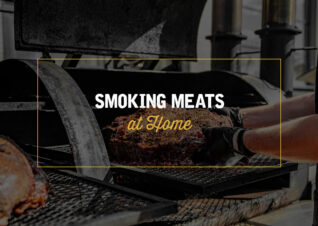





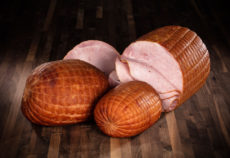


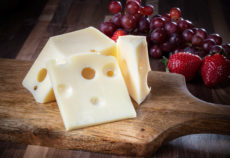
I’ve been told that a Toupie ham is the best – your opinion? And how is it different from your other examples?
Does one cut / type of ham lend itself better for making a ham loaf?
I got a bone-in whole ham of 14lbs. the butcher shop smokes their own hams. We cooked it slow for 5 hours and glazed it often. It looked beautiful. BUT IT TASTED LIKE A PORK ROAST. DOES this mean they did not brine it? Or was it from the front leg? Should the butcher have told us it doesn’t taste the way most hams taste? thank you Joan
Freash picnic ham turn brown after cooking WHY
I’d love to surprise him with a real English breakfast best way is to take him to England , Da .
What or which ham would be considered best for HAM SALAD”!
Especially the old fashion ham salad using
Ham
Mayo
Pickles diced & Relish
What is a tavern ham? I prefer it to the regular rectangle-shaped grocery ham, other than the appearance (I’ve never seen a rectangular-bottomed pig) and yes, the taste.
Cottage Han and picnic hash were not brought up
I truly enjoyed the information you’ve been so kind to share. There are many types of ham and just as many stories that accompany them. I hope this will foster more interest in the subject!!!! Thank you!!
What about rum ham?
Hi Sandra!
We readily have Virginia Country Ham available whole, sliced and in pieces at our East Petersburg location. Feel free to give us a call at (717) 569-0812 for more information.
Thanks!
Good morning,
Please let me know if Virginia country ham is available in the local area? I am very interested.
Hi, Danielle!
The butcher that you spoke to was spot on! Back bacon is the most widely-used cut of bacon in England. Canadian bacon is actually a form of back bacon, but it is cut and processed differently than traditional English bacon. Specifying that you are looking for English-style back bacon should help you have the English breakfast that you’re looking for!
Can you tell me what English bacon is? Many people in the states think it is the same as Canadian bacon, but it definately is not. I’ve been told by a British butcher that it is “back bacon” but I’d like to know how I would ask for it from a butcher- my husband is English & I’d love to surprise him with a real English breakfast…